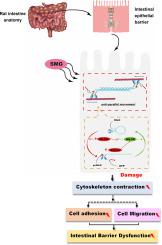Journal of Proteomics ( IF 2.8 ) Pub Date : 2020-10-07 , DOI: 10.1016/j.jprot.2020.104001 Shibo Wang 1 , Rui Wang 1 , George Q Li 2 , Jun-Lae Cho 3 , Yulin Deng 1 , Yujuan Li 1

|
Microgravity induces injury of intestinal barrier. However, the underlying mechanism remains unclear. The present study aimed to investigate the pathological change of intestinal mucosa induced by long term simulated microgravity and to explore its etiological mechanism using a proteomic approach. The well accepted tail-suspended rat model was used to simulate microgravity. The damage of rat small intestine was evaluated via histological and molecular test, and a label-free comparative proteomic strategy was used to determine the molecular mechanism. Simulated microgravity for 21 days damaged intestine barrier with decreased numbers of the goblet cells, large intercellular space, and down-regulated adhesion molecules, accompanied by increased intestinal permeability. Proteomic analysis identified 416 differentially expressed proteins and showed simulated microgravity dramatically down-regulated the adhesion molecules and deteriorated several pathways for metabolism, focal adhesion, and regulation of actin cytoskeleton. Western-blot analysis confirmed that myosin regulatory light chain (MLC) 12B was significantly down-regulated, while rho-associated protein kinase, myosin light chain kinase (MLCK), and phosphorylated MLC were dramatically up-regulated. Taken together, these data reveal that down-regulation of adhesion molecules and MLCK dependent up-regulation MLC phosphorylation mediate intestinal barrier dysfunction during simulated microgravity injury. Our results also indicate that regulation of epithelial MLCK is a potential target for the therapeutic treatment of microgravity injury.
中文翻译:

基于蛋白质组学策略的模拟微重力后肌球蛋白轻链激酶介导肠道屏障功能障碍
微重力诱发肠屏障损伤。然而,潜在的机制仍不清楚。本研究旨在研究长期模拟微重力引起的肠黏膜病理变化,并采用蛋白质组学方法探讨其病因机制。广为接受的尾悬大鼠模型用于模拟微重力。通过组织学和分子学测试评估大鼠小肠的损伤,并使用无标记的比较蛋白质组学策略确定分子机制。模拟微重力 21 天,肠道屏障受损,杯状细胞数量减少,细胞间隙变大,粘附分子下调,肠道通透性增加。蛋白质组学分析确定了 416 种差异表达的蛋白质,并显示模拟微重力显着下调了粘附分子,并恶化了代谢、粘着斑和肌动蛋白细胞骨架调节的几种途径。Western-blot 分析证实,肌球蛋白调节轻链 (MLC) 12B 显着下调,而 rho 相关蛋白激酶、肌球蛋白轻链激酶 (MLCK) 和磷酸化 MLC 显着上调。总之,这些数据表明,在模拟微重力损伤期间,粘附分子的下调和 MLCK 依赖性上调 MLC 磷酸化介导了肠道屏障功能障碍。我们的研究结果还表明,上皮 MLCK 的调节是微重力损伤治疗的潜在靶点。











































 京公网安备 11010802027423号
京公网安备 11010802027423号